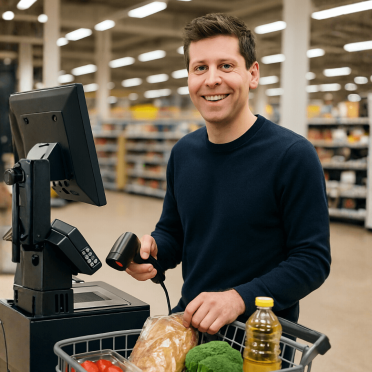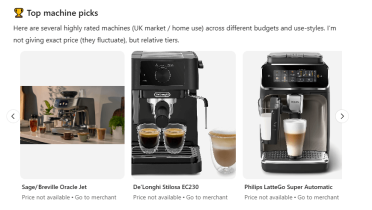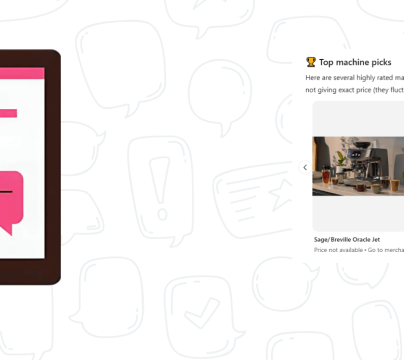OpenAI’s latest shopping update has landed in ChatGPT, and it’s quietly (or maybe more so loudly now), doing what Google Shopping and Amazon Ads have done for years. Except it’s free (for now), tightly integrated into search, and backed by some fairly heavyweight tech.
If you run an ecommerce site, especially heading into 2026, this is something worth paying attention to. ChatGPT’s shopping integration could (and likely will) play a fundamental role in getting your products off the shelf and into someone’s basket.

What is ChatGPT’s new shopping update?
Think of it as a shopping carousel, powered by ChatGPT’s ability to understand how people actually talk. I tested it recently by asking something like “Best at-home espresso machine?”
Instead of a basic list, it gave me a detailed response with real product suggestions. Prices, retailers, reviews, all shown in a clean carousel right inside the chat. No search results page. No ads. No need to click away.
But the carousel is just the start. ChatGPT adds extra context too, like why certain products were recommended or what other users tend to like. Ask a follow-up question and it adapts, refining suggestions by price, features or preferences as the conversation continues.
It might sound similar to Google Shopping, but it’s more than a product feed. This is a guided and conversational way to shop that feels more like getting advice than clicking through a sales page.

How it works
ChatGPT’s shopping results are powered by structured product data from across the web. This includes things like price, availability, images, and descriptions, pulled from a mix of first-party websites and third-party sources.
While the full process behind how products are selected hasn’t been officially detailed, it’s clear that well-structured content plays a key role. Pages with clean schema markup and accurate product information are far more likely to be picked up and shown in results.
If structured data has been sitting on your to-do list, now’s a good time to tick it off.
The ecommerce opportunity in 2025 and beyond
It’s rare that a new search surface arrives that’s not already dominated by Amazon or guarded behind a hefty ad spend. Right now, ChatGPT shopping listings are free, organic, and open. However, there's chatter that this likely won’t last forever.
Could OpenAI be gearing up to offer their own paid ad solution? Quite possibly. Sam Altman’s previous “I hate ads” stance has already shifted to something closer to “maybe they don’t suck” as covered here . If OpenAI finds the right format that doesn’t feel invasive, a monetised version of these listings could follow soon enough.
For ecommerce businesses using platforms like WooCommerce, Shopify, or Drupal Commerce, this is a chance to get ahead. You’re no longer just writing for Google’s search algorithm. You’re also writing for a chatbot that speaks in full sentences and wants to show off your products in conversation.
How to improve your chances of being featured
Here’s what ecommerce site owners should be doing now to show up in ChatGPT shopping results:
1. Sort out your structured data
Structured data (schema markup) doesn’t guarantee visibility on its own, but it helps AI tools and search engines find and interpret the key elements that actually matter. Focus on exposing clear, crawlable product information such as name, brand, price, availability, description, and reviews directly in your HTML. Schema is simply a structured wrapper that reinforces what’s already there.
In other words, ChatGPT and similar AI systems look at the content within the schema, not the markup itself. If those details are buried in JavaScript or missing from the visible page, the crawler won’t see them, no matter how perfect your schema syntax is.
It’s good for SEO, good for AI, and a smart move for any ecommerce site that wants its products to surface naturally in both search and conversational results.
2. Don’t bury the detail
Product descriptions need to be clear, detailed and easy to understand. Skip the jargon and focus on what matters most to your customer. If someone asks a question like “What’s the best option for everyday use?”, your content should already be answering it. ChatGPT picks up on context, so the more helpful and human your copy is, the more likely it is to surface in results.
3. Use real customer reviews
ChatGPT responds well to sentiment, much like traditional SEO. If your product pages include detailed, genuine customer reviews, you’re more likely to appear when someone searches for “top rated” or “most recommended” items. Just as reviews help boost trust and visibility in Google, they also improve your chances of being surfaced in ChatGPT.
Make sure your reviews are part of your schema markup too, so they’re readable by both search engines and AI tools.
4. Think like a shopper, not a brand
People aren’t always searching for your brand, they’re searching for a solution, a product, or an answer. Your job is to make sure you show up when they do. That means writing product titles and descriptions in the same language your customers use, not just internal labels or technical terms. Speak their language, and you stand a much better chance of being found.
A few things to keep in mind
Not every query will show the shopping carousel. Even when using the latest GPT models, responses can vary. I’ve tested a few examples, including our espresso machine test and a fairly specific search for the best mini mechanical keyboard, and sometimes I got product suggestions, other times just text. The rollout still seems limited, so if you’re not seeing product cards every time, that’s normal for now.
It’s also worth knowing that many of the bots and scrapers used to collect content for these tools don’t run JavaScript. If your prices, reviews or product details are only shown through JavaScript, they might not be picked up at all. To give your products the best chance of being found, make sure the key content is present in the raw HTML and marked up properly with schema. And if you’re wondering why product listings are becoming a bigger part of the picture, it might have something to do with OpenAI’s recent shift to a for-profit business model. You can read more about that here.
What this means for Google, Amazon, and everyone else
OpenAI is clearly eyeing up a chunk of the product search pie. Amazon owns the buyer-intent search crowd. Google owns the generic search. ChatGPT is carving out a space for conversational, specific, guided shopping. A kind of product search concierge that doesn’t charge commission.
The early days of SEO were about figuring out what Google wanted. This new era feels more about figuring out what AI understands. And right now, that’s a surprisingly low-friction playing field for e-commerce brands who are prepared.
With all that in mind, if you’re thinking “Great... but what now?”, we’re here to help. Whether you need a second pair of eyes on your product pages or want to know where to start, we can take a look, run through a quick audit, and recommend the next steps that’ll make the biggest impact.

